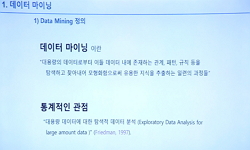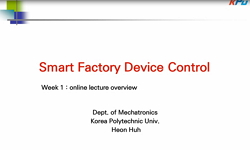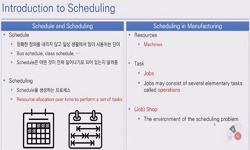Background: Although researches on algorithms, programming languages, and data analysis techniques for manufacturing data analysis platform(MDAP), which applies big data and artificial intelligence analysis techniques, is active, research on the inter...
http://chineseinput.net/에서 pinyin(병음)방식으로 중국어를 변환할 수 있습니다.
변환된 중국어를 복사하여 사용하시면 됩니다.
- 中文 을 입력하시려면 zhongwen을 입력하시고 space를누르시면됩니다.
- 北京 을 입력하시려면 beijing을 입력하시고 space를 누르시면 됩니다.

중소 제조공장을 위한 제조데이터 분석 플랫폼의 모바일 SW 인터페이스 연구 = A Study on Software the Mobile Interfaces of a Manufacturing Data Analysis Platform for SMEs
한글로보기https://www.riss.kr/link?id=A106950860
- 저자
- 발행기관
- 학술지명
- 권호사항
-
발행연도
2020
-
작성언어
Korean
-
주제어
스마트팩토리 ; 제조데이터 분석 ; 정보디자인 ; UI ; Smart Factory ; Manufacturing Data Analysis ; Information Design ; UI
-
등재정보
KCI등재
-
자료형태
학술저널
-
수록면
71-88(18쪽)
-
KCI 피인용횟수
0
- DOI식별코드
- 제공처
-
0
상세조회 -
0
다운로드
부가정보
다국어 초록 (Multilingual Abstract)
Methods: In this study, we first researched the smart factory and its data collection and analysis system, also considered prior studies related to the interface of the IoT platform. Next, the interface types according to the output devices were analyzed. Also, the method and the structure of mobile interfaces are suggested in the form of a user-customized interface and an interactive interface, chatbot. Finally, the heuristics of experts were conducted and verified.
Result: As a result of the study, we proposed the mobilization of MDAP and presented an interface format that can actively utilize artificial intelligence platforms. The interface using the monitor follows the existing graph or list format, while the mobile interface proposes a custom interface and an interactive interface to increase portability, intuitiveness, and accessibility. The customized interface was configured to be classified according to the situation and work type, and the interactive interface was configured to be able to communicate through push notifications and to use text-based chatbots and voice-based chatbots together.
Conclusion: This study aims to improve the MDAP usability of small and medium-sized manufacturing plants and promote its introduction. Also, it aims to promote smartization by providing customized interfaces to small and medium-sized manufacturing plants.
Background: Although researches on algorithms, programming languages, and data analysis techniques for manufacturing data analysis platform(MDAP), which applies big data and artificial intelligence analysis techniques, is active, research on the interface is still insufficient. MDAP's manufacturing data output is still dependent on monitors. Also, the information visualized in graphs or diagrams is not intuitive, so it is not easy enough to analyze without trained staff. Small and medium-sized enterprises(SMEs) struggle not only with technical issues but also with costs when adopting the platform. Therefore, this study intends to propose an interface that is intuitive and highly accessible so that MDAP for SMEs can be operated without dedicated staff.
Methods: In this study, we first researched the smart factory and its data collection and analysis system, also considered prior studies related to the interface of the IoT platform. Next, the interface types according to the output devices were analyzed. Also, the method and the structure of mobile interfaces are suggested in the form of a user-customized interface and an interactive interface, chatbot. Finally, the heuristics of experts were conducted and verified.
Result: As a result of the study, we proposed the mobilization of MDAP and presented an interface format that can actively utilize artificial intelligence platforms. The interface using the monitor follows the existing graph or list format, while the mobile interface proposes a custom interface and an interactive interface to increase portability, intuitiveness, and accessibility. The customized interface was configured to be classified according to the situation and work type, and the interactive interface was configured to be able to communicate through push notifications and to use text-based chatbots and voice-based chatbots together.
Conclusion: This study aims to improve the MDAP usability of small and medium-sized manufacturing plants and promote its introduction. Also, it aims to promote smartization by providing customized interfaces to small and medium-sized manufacturing plants.
국문 초록 (Abstract)
연구방법: 본 연구에서는 먼저 스마트팩토리와 이의 데이터 수집 분석 시스템에 대해 알아보고 IoT 플랫폼의 인터페이스에 관련된 선행연구를 고찰하였다. 다음으로 출력기기에 따른 인터페이스 형태를 분석했다. 그리고 모바일 인터페이스의 방식과 구조를 사용자 맞춤형 인터페이스와 대화형 인터페이스인 챗봇의 형식으로 제시하였고 전문가 휴리스틱을 진행하여 검증했다.
연구결과: 연구 결과, 제조데이터 분석 플랫폼의 모바일화를 제안하고 인공지능 플랫폼을 적극적으로 활용할 수 있는 인터페이스 형식을 제시하였다. 모니터를 이용한 인터페이스는 기존의 그래프나 리스트 형식을 따르고 모바일 인터페이스에서는 휴대성과 직관성, 접근성을 높이기 위해 맞춤형 인터페이스와 대화형 인터페이스를 제안하였다. 맞춤형 인터페이스는 상황별 분류와 업무 형태별 분류가 가능하도록 구성하였고, 대화형 인터페이스는 푸시 알림을 통해 소통할 수 있고, 텍스트 기반 챗봇, 음성 기반 챗봇을 함께 사용할 수 있는 형식으로 구성하였다.
결론: 본 연구는 중소 제조공장에 인공지능을 활용한 제조데이터 분석 플랫폼의 사용성을 높여 보급을 활성화하기 위한 연구로, 중소 제조공장에게 맞춤형 인터페이스를 제공함으로서 중소 제조공장의 스마트화를 촉진하는 데에 의의가 있다.
연구배경: 센서 기술에 빅데이터와 인공지능 분석기술이 적용된 제조데이터 분석 플랫폼에 대한 알고리즘 관련 연구나 프로그램 언어 등 분석 기법 등의 연구는 활발하지만 인터페이스에 ...
연구배경: 센서 기술에 빅데이터와 인공지능 분석기술이 적용된 제조데이터 분석 플랫폼에 대한 알고리즘 관련 연구나 프로그램 언어 등 분석 기법 등의 연구는 활발하지만 인터페이스에 관련된 연구는 아직 미흡하다. 제조데이터를 출력하는 방식도 아직 모니터에 의존하고 있고, 그래프나 도표로 시각화된 정보는 직관적이지 않아 훈련받은 전담직원 없이는 분석이 어렵다. 중소기업은 플랫폼 도입시 기술적인 문제는 물론 비용도 고심한다. 따라서 본 연구에서는 중소기업을 위한 제조데이터 분석 플랫폼을 전문지식을 학습한 전담직원 없이도 운용이 가능하도록 직관적이고 접근성이 높은 쉬운 인터페이스를 제안하고자 한다.
연구방법: 본 연구에서는 먼저 스마트팩토리와 이의 데이터 수집 분석 시스템에 대해 알아보고 IoT 플랫폼의 인터페이스에 관련된 선행연구를 고찰하였다. 다음으로 출력기기에 따른 인터페이스 형태를 분석했다. 그리고 모바일 인터페이스의 방식과 구조를 사용자 맞춤형 인터페이스와 대화형 인터페이스인 챗봇의 형식으로 제시하였고 전문가 휴리스틱을 진행하여 검증했다.
연구결과: 연구 결과, 제조데이터 분석 플랫폼의 모바일화를 제안하고 인공지능 플랫폼을 적극적으로 활용할 수 있는 인터페이스 형식을 제시하였다. 모니터를 이용한 인터페이스는 기존의 그래프나 리스트 형식을 따르고 모바일 인터페이스에서는 휴대성과 직관성, 접근성을 높이기 위해 맞춤형 인터페이스와 대화형 인터페이스를 제안하였다. 맞춤형 인터페이스는 상황별 분류와 업무 형태별 분류가 가능하도록 구성하였고, 대화형 인터페이스는 푸시 알림을 통해 소통할 수 있고, 텍스트 기반 챗봇, 음성 기반 챗봇을 함께 사용할 수 있는 형식으로 구성하였다.
결론: 본 연구는 중소 제조공장에 인공지능을 활용한 제조데이터 분석 플랫폼의 사용성을 높여 보급을 활성화하기 위한 연구로, 중소 제조공장에게 맞춤형 인터페이스를 제공함으로서 중소 제조공장의 스마트화를 촉진하는 데에 의의가 있다.
참고문헌 (Reference)
1 "플랫폼 개발사 위미르 제공 자료"
2 백현지, "챗봇 기반 인터페이스의 상호작용성과 사용 모드가 사용자 경험에 미치는 영향" 한국에이치씨아이학회 14 (14): 35-43, 2019
3 YTN 사이언스, "제조업의 미래. 스마트팩토리[다큐프라임]"
4 고동범, "제조설비 데이터 수집 표준을 이용한설비 데이터 시각화에 대한 연구" 한국인터넷방송통신학회 18 (18): 159-166, 2018
5 남민경, "제조 데이터 분석 플랫폼의 모바일 터미널 사용자 연구 -창원 스마트산단 사례를 중심으로-" 한국디자인문화학회 26 (26): 145-159, 2020
6 이소라, "인공지능에 기반한 저시력인을 위한 음성 지원 앱의 개발" 한국디지털콘텐츠학회 21 (21): 277-284, 2020
7 과학기술정보통신부, "인공지능(AI) 국가전략 발표"
8 김예림, "의료정보전달을 고려한 국민건강검진 결과지 디자인 개선" 디자인연구소 17 (17): 93-102, 2018
9 산업일보, "스마트팩토리가 제조업과 세계 경제에 미치는 영향"
10 한국산업단지공단, "스마트산단 선도 프로젝트"
1 "플랫폼 개발사 위미르 제공 자료"
2 백현지, "챗봇 기반 인터페이스의 상호작용성과 사용 모드가 사용자 경험에 미치는 영향" 한국에이치씨아이학회 14 (14): 35-43, 2019
3 YTN 사이언스, "제조업의 미래. 스마트팩토리[다큐프라임]"
4 고동범, "제조설비 데이터 수집 표준을 이용한설비 데이터 시각화에 대한 연구" 한국인터넷방송통신학회 18 (18): 159-166, 2018
5 남민경, "제조 데이터 분석 플랫폼의 모바일 터미널 사용자 연구 -창원 스마트산단 사례를 중심으로-" 한국디자인문화학회 26 (26): 145-159, 2020
6 이소라, "인공지능에 기반한 저시력인을 위한 음성 지원 앱의 개발" 한국디지털콘텐츠학회 21 (21): 277-284, 2020
7 과학기술정보통신부, "인공지능(AI) 국가전략 발표"
8 김예림, "의료정보전달을 고려한 국민건강검진 결과지 디자인 개선" 디자인연구소 17 (17): 93-102, 2018
9 산업일보, "스마트팩토리가 제조업과 세계 경제에 미치는 영향"
10 한국산업단지공단, "스마트산단 선도 프로젝트"
11 차경진, "사용자경험을 극대화 하기 위한 보이스기반 대화형 사용자인터페이스 디자인설계에 대한 연구" 2018
12 최수민, "모바일 메신저 기반 인공지능 챗봇의 상품 주문결제 인터페이스 연구" 2017
13 윤유동, "기계 학습 방법을 이용한 활동 프로파일 기반의 스마트 시니어 분류 모델 개발" 한국융합학회 8 (8): 25-34, 2017
14 곽재혁, "고성능컴퓨팅 환경을 고려한 빅데이터플랫폼 운영관리시스템 개발" 한국정보과학회 47 (47): 240-246, 2020
15 경남도청, "경남창원스마트산단. 창원 국가산업단지 조성을위한 마스터플랜, 창원국가산업단지 위치도"
16 임정혁, "Unfiltered Symptom Description을반영한 머신러닝과 NLU 기반 자가검진 챗봇 어플리케이션 디자인에 대한 연구" 2019
17 연합뉴스, "MS “모든 것에 지능을...”...“앱은 가고 AI 시대 왔다”(종합)"
18 송지성, "IoT 스마트 디바이스의 서비스 사용성 연구" 한국디자인문화학회 25 (25): 327-336, 2019
19 Yan, M., "Building a Chatbot with Serverless Computing" 1 : 2016
20 산업일보, "5G 스마트팩토리, 국내 제조업 경쟁력 끌어올릴 것"
동일학술지(권/호) 다른 논문
-
- 인제대학교 디자인연구소
- 이은정
- 2020
- KCI등재
-
소셜 네트워크의 인증문화가 전시에 미친 영향과 전시 콘텐츠 디자인의 새로운 가능성
- 인제대학교 디자인연구소
- 김태윤
- 2020
- KCI등재
-
주제 분석 방법 (Thematic Analysis)을 통한 Z세대 여성 유튜브 뷰티 동영상 경험분석에 관한 연구
- 인제대학교 디자인연구소
- 박유선
- 2020
- KCI등재
-
The accuracy and sufficiency of information in the blood pressure chart
- 인제대학교 디자인연구소
- 한영애
- 2020
- KCI등재
분석정보
인용정보 인용지수 설명보기
학술지 이력
| 연월일 | 이력구분 | 이력상세 | 등재구분 |
|---|---|---|---|
| 2027 | 평가예정 | 재인증평가 신청대상 (재인증) | |
| 2021-01-01 | 평가 | 등재학술지 유지 (재인증) |  |
| 2018-01-01 | 평가 | 등재학술지 유지 (등재유지) |  |
| 2016-03-15 | 학술지명변경 | 외국어명 : 미등록 -> Journal of Integrated Design Research |  |
| 2015-01-01 | 평가 | 등재학술지 선정 (계속평가) |  |
| 2014-03-24 | 학술지명변경 | 한글명 : Journal of Digital Interaction Design -> Journal of Integrated Design Research |  |
| 2013-01-01 | 평가 | 등재후보학술지 유지 (기타) |  |
| 2012-01-01 | 평가 | 등재후보학술지 유지 (기타) |  |
| 2010-01-01 | 평가 | 등재후보학술지 선정 (신규평가) |  |
학술지 인용정보
| 기준연도 | WOS-KCI 통합IF(2년) | KCIF(2년) | KCIF(3년) |
|---|---|---|---|
| 2016 | 0.29 | 0.29 | 0.31 |
| KCIF(4년) | KCIF(5년) | 중심성지수(3년) | 즉시성지수 |
| 0.37 | 0.34 | 0.528 | 0.09 |




 KCI
KCI DBpia
DBpia






